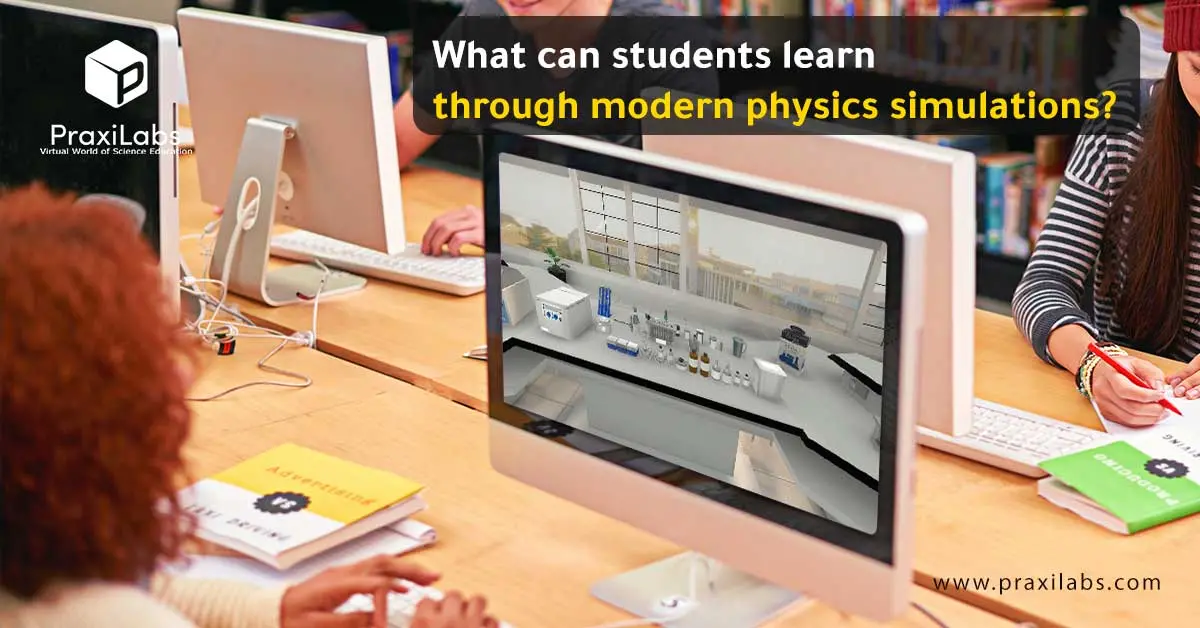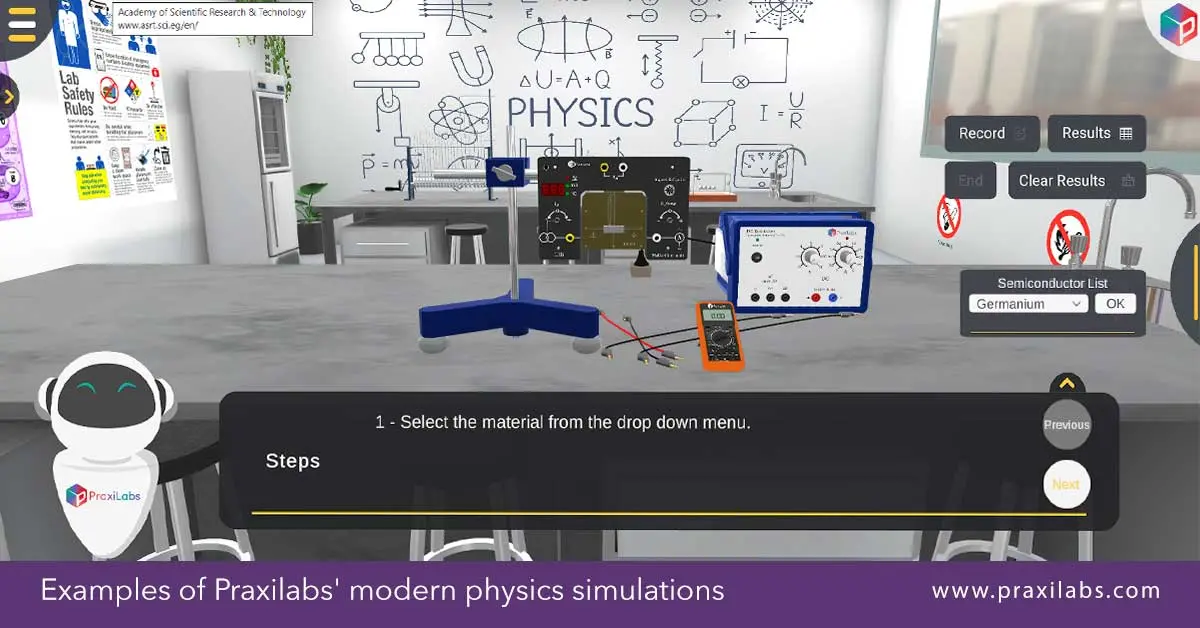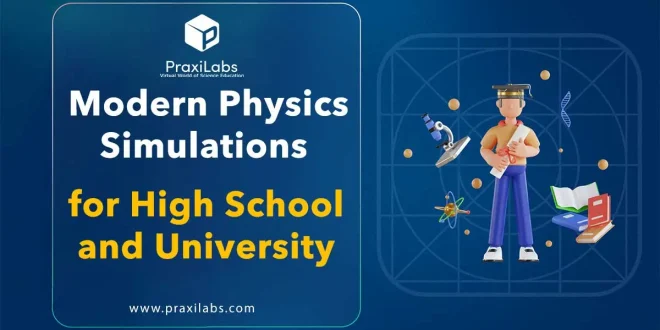Last Updated on September 30, 2025 by Muhamed Elmesery
Modern physics simulations are transforming the way high school and university students explore complex scientific concepts. Instead of relying solely on equations and static diagrams, learners can now interact with dynamic, virtual experiments that bring abstract theories—like quantum mechanics, relativity, and particle physics—into vivid, hands-on experiences.
These simulations not only make physics more engaging but also bridge the gap between theory and real-world application, helping students develop a deeper understanding and curiosity about the subject.
Table of Contents
What are modern physics simulations?
Modern physics simulations 3D are e-learning methods that rely on computers to simulate the real laboratory environment and conduct physics experiments in several topics such as black body radiation, the Stefan-Boltzmann law of radiation, the characteristics of a solar cell, and the laser electro-optic effect to help students understand the universe, develop technology, and learn physics concepts.
These simulations help visualize abstract concepts, conduct virtual experiments without physical equipment, and solve complex problems that lack exact analytical solutions.
Advantages of using simulations in physics education
An enhanced educational experience
Simulations in physics education provide an immersive, interactive learning environment that boosts student engagement. This facilitates a deeper understanding of complex scientific principles, encouraging students to focus on and manipulate variables during experiments, as well as to monitor outcomes.
This hands-on approach fosters critical thinking and problem-solving skills, which are essential for success in the fields of science, technology, engineering, and mathematics.
Accessibility 24/7
One of the most important advantages of virtual science simulations is that students can access labs anytime, anywhere, enabling them to work on experiments at their convenience. This provides students with independence and excellent time management capabilities.
Scalability
As student numbers grow, experimental simulation platforms allow easy scalability without the need for physical expansion of laboratory spaces or the purchase of additional equipment. Institutions can seamlessly accommodate more users, ensuring all students have access to essential resources regardless of classroom size.
Developing familiarity with digital technological advancement
The integration of virtual labs into curricula helps students develop essential digital literacy skills that are increasingly important in today’s technology-driven world. Familiarity with virtual lab environments prepares students for future technological advancements and enhances their ability to adapt to various professional settings.
Preparing students for real-world applications
Virtual science labs mimic real-world scenarios that prepare students for future careers in science and technology fields. By engaging in realistic simulations, students develop practical skills that align with those needed in professional environments, making them more competitive in the job market.
Supporting remote learning
The emergence of remote and hybrid learning models requires robust online infrastructure to support the delivery of effective education. Virtual lab platforms facilitate remote learning by allowing students to access advanced programs and tools from anywhere, promoting inclusivity and accommodating diverse learning needs.
How do physics simulations work?
Physics simulations work by creating immersive and interactive 3D environments where students can perform 3D experiments online remotely, mimicking real-world laboratory settings.
These simulations utilize mathematical models and physics principles to simulate physical phenomena, allowing students to explore concepts and visualize results without the need for physical equipment or lab space.

What can students learn through modern physics simulations?
Through modern physics simulation software, students can:
- Visualize abstract concepts like quantum mechanics and relativity.
- Connect mathematical equations with real-world outcomes.
- Design and analyze experiments safely and efficiently.
- Gain practical skills with virtual physics lab tools.
- Strengthen critical thinking by testing “what-if” scenarios.
- Explore real-world applications in technology, medicine, and space.
- Modern physics experiments simulations help students grasp complex ideas, practice inquiry, and link physics to everyday innovations.
What is the best simulation platform for physics?
When we talk about innovation in virtual education, the name PraxiLabs stands out as one of the best simulation platforms for physics and a leading pioneer in this field.
While experiential education faces challenges related to the cost of laboratories, limited resources, and the difficulty of providing a safe environment for all students, PraxiLabs has come up with a revolutionary solution through three-dimensional virtual science laboratories.
PraxiLabs offers a complete solution for the virtual learning environment, which not only aims to provide a basic “tool” that educational institutions can use but also offers:
- A comprehensive, interactive, and rich learning experience
By making scientific experiments accessible to everyone through its platform, PraxiLabs provides hundreds of experiments in the fields of chemistry, physics, and biology. These experiments accurately simulate real laboratories, allowing students to conduct experiments anytime and anywhere, without the need for expensive equipment or special requirements.
- Support for Educational Institutions
PraxiLabs has successfully established partnerships with universities and schools around the world, including universities in Egypt, the United States, Mexico, and other Arab countries such as Saudi Arabia and Oman. This support has enabled educational institutions to integrate virtual laboratories into their curricula, enhancing the educational process with advanced digital tools.
- Enhancing Students’ Academic and Research Skills
The interactive experiments in the virtual science labs offered by PraxiLabs are not limited to theoretical aspects; they also foster critical thinking, analysis, and inference skills. The student does not simply observe the experiment but actively participates in it, learning how to deal with mistakes and repeat attempts until achieving correct results.
- Reducing Costs and Increasing Safety
Relying on virtual laboratories significantly reduces the costs of equipping and maintaining traditional laboratories, while also ensuring a safe educational environment free from chemical hazards or human errors that could occur in real laboratories, potentially leading to major disasters.

Examples of Praxilabs’ modern physics simulations
Modern physics lab experiments can feel abstract and hard to replicate in real labs. PraxiLabs makes it accessible through interactive simulations that let students explore key experiments safely and easily.
Black Body Radiation and Stefan-Boltzmann Law of Radiation
By the end of the black body radiation simulation, the student should be able to:
- Explain blackbody radiation.
- Interpret Planck’s curve for the radiation emitted by a hot body.
- Correlate the relationship between the temperature of the black body and the wavelength at which the intensity of the radiation emitted by it is maximum.
- Inspect the applicability of the Inverse Square Law to the case of the radiation emitted by a black body.
Other modern physics simulations include:
- Band Gap Energy of Semiconductors
- Characteristics of Solar Cell (I), Dark and illumination I-V characteristics of a solar cell
- Characteristics of Solar Cell (II), Effect of the exposed area, and the intensity of the incident light on the optimum power output of the solar cell
- Characteristics of Solar Cell (III), Study of the Spectral Dependence of the I-V Characteristics as well as the Effect of Connection method on the I-V Characteristics of a solar cell
- Laser Beam Simulator (Divergence)
- Laser Electro-Optic Effect
- Michelson’s Interferometer
- Millikan Oil Drop Simulation
- Optics Lab
- Zeeman Effect Simulation
Pick the Best Virtual Plan or You
Frequently Asked Questions
What is meant by modern physics?
Modern physics is a branch of physics that studies phenomena beyond the scope of classical physics, particularly at extreme conditions like high velocities, small scales (atomic and subatomic), and high energies.
Are simulations more engaging than traditional labs?
Simulations can be more engaging due to their interactivity and flexibility, allowing for experimentation with fewer restrictions and immediate feedback, but traditional labs often offer a more satisfying and authentic hands-on experience that some students prefer.
 PraxiLabs A virtual world of science
PraxiLabs A virtual world of science






